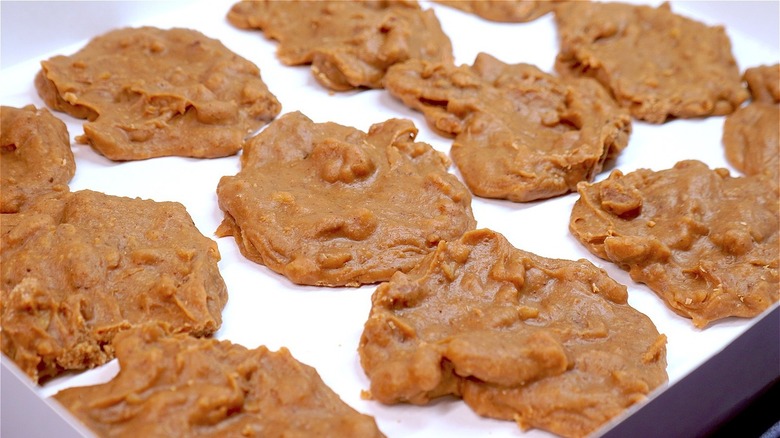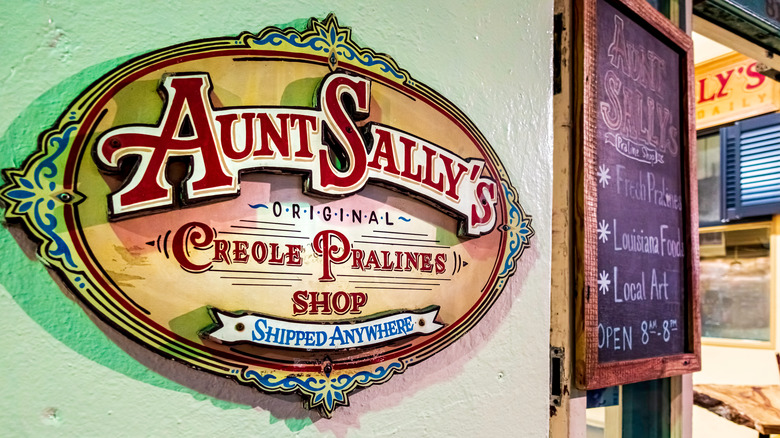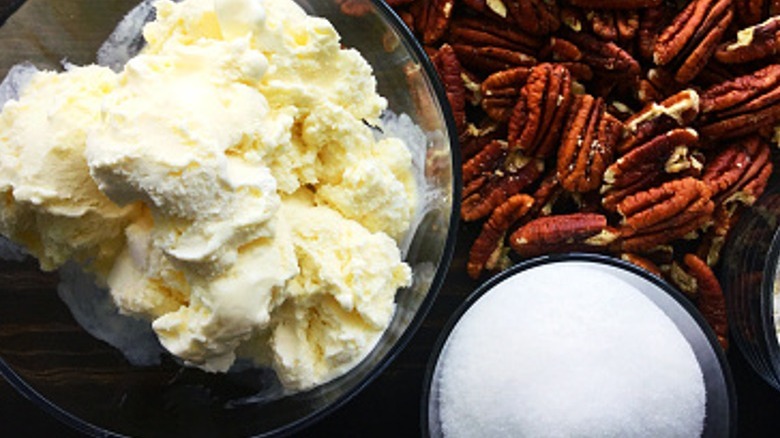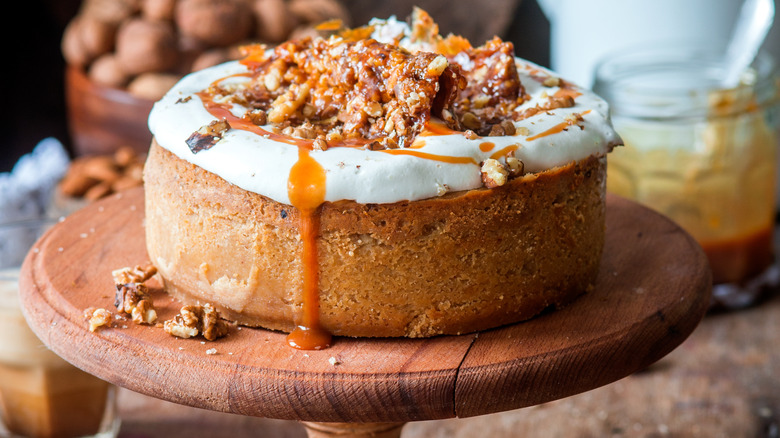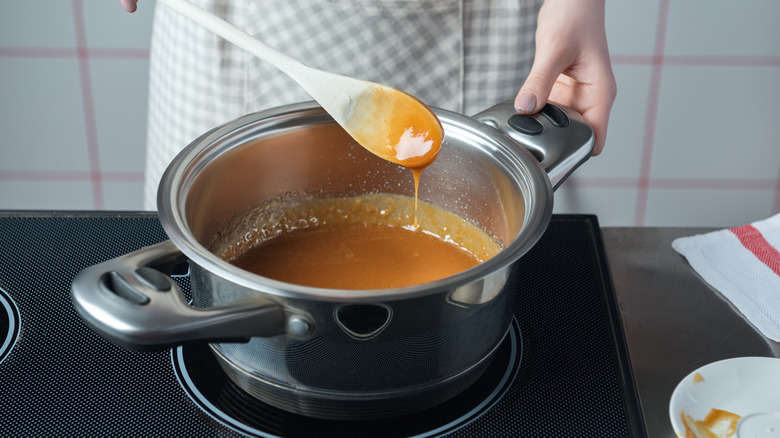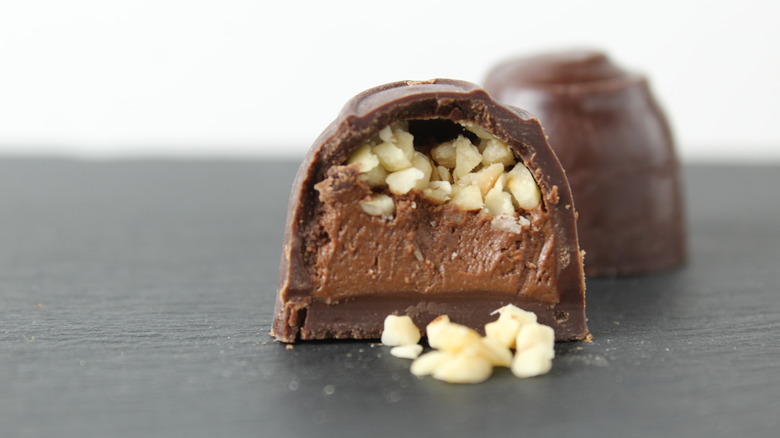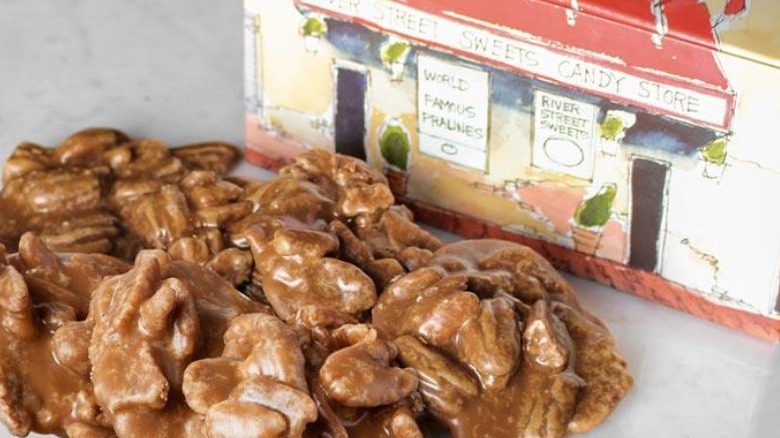What Is A Praline (And How Do You Pronounce It)?
You know how there are some words you read a million times, but then you realize that you're still not exactly sure how to say out them loud? Well, if "praline" is one of those words, there's no need to be embarrassed. Pralines, which are delicious brown sugar-based candy patties with a fudgy consistency and pecan topping, can be pronounced in one of two different ways.
If you've been saying — or thinking — the word as "pray-lean" all along, that's perfectly okay, it just means that you're aligning yourself with the Georgia axis. If you say it "prah-lean," then your accent and allegiance are trending more towards the southwest since that is how they usually pronounce the word in Louisiana and its environs. If you're saying it any other way, well, you do you (bless your little heart). No matter how you speak the word, that which we call a praline by any other name would still taste as sweet.
The history of pralines
The very earliest pralines are thought to date back to 17th-century France and may, in fact, take their name from that of the Comte du Plessis-Praslin, a nobleman who employed the chef who is said to have created them. These candies were made with almonds, but when the recipe was brought to New Orleans in the 18th century by an order of Ursuline nuns who made this New World city their new home, they adapted to using locally-grown pecans instead.
While the first American pralines were said to have been made by the nuns' proteges, they were popularized by street vendors called pralinières who sold their wares throughout the city in the 19th century. The pralinières were typically free Black women or, in some cases, enslaved ones who were permitted to earn a little money of their own on their day off. Despite being caricatured as Aunt Jemima-style "mammy" stereotypes, these praline sellers nevertheless served as an early example of entrepreneurship among both women and people of color. Still, as the 19th century gave way to the 20th, pralines, too, went corporate. One long-established company, Aunt Sally's, opened up shop in 1935 in the same French Market where pralinières had plied their trade decades before. Aunt Sally's is still thriving nearly 90 years later, selling New Orleans' classic candies to the city's numerous tourists.
What goes into a praline?
A typical praline starts with sugar, either white, brown, or a mixture of both. (Many feel that the combination of the two leads to the best texture and flavor.) If white sugar alone is used, baking soda may also be added as it helps the paler sugar to caramelize. Butter is used to give the pralines their smooth texture, while milk helps make the candies creamy. Actual cream can also be used, as can evaporated milk. Vanilla extract also features in some, but not all, recipes, as does a pinch of salt. The subtle flavors from either or both of these elements are a matter of personal choice.
As for the nuts, New Orleans-style pralines are made with pecans (or pe-cahns, if you want to go down another orthoepical rabbit hole). You can, of course, use any other nuts you like and you'll still have a praline, if perhaps a less traditional one. Almonds and hazelnuts would be fitting as these are in line with the praline's European roots, but pistachios, cashews, macadamias, or walnuts are also great options. Peanuts would be good, too, as well as being more budget-friendly than most other nuts, while pepitas or sunflower seeds (sans shells) can make for a praline-like candy suitable for anyone with a nut allergy.
Praline variations showcase the candy's versatility
Nuts aren't the only thing that can be switched up when you're making a praline. Once cooked, pralines can be topped with melted chocolate, or the candy patty itself can be flavored with cocoa powder. Other flavor variants include coffee, maple, peanut butter, rum, and even Tabasco sauce (itself another Louisiana specialty). We ourselves have a bourbon praline recipe that you might want to try if you're a fan of boozy candy.
Pralines can also be used as an ingredient to make a variety of different desserts. The simplest of these is to melt or crumble a stale praline (sadly they stay fresh for just a few days, although some might say minutes) over a bowl of ice cream. If you add some whipped cream you'll have yourself a praline sundae, or you could drizzle on caramel sauce for something akin to Baskin-Robbins' own Pralines 'N Cream flavor. Throw the candy and ice cream into the blender with a splash of milk and a praline milkshake can be yours. You can also chop up pralines to make a sweet and crunchy topping or filling for pies and cakes (we do something similar with our chocolate praline layer cake recipe) or stir them into a cheesecake or cookie batter. If you like sweet and salty stuff, you might even want to try adding crumbled pralines to a bowl of popcorn to make a fancied-up kind of Cracker Jack.
This is how you make pralines
Praline making is deceptively simple and yet sort of complicated all at the same time. Essentially, what you are doing is mixing sugar with milk or cream and cooking it until it caramelizes. While caramelizing actual caramel doesn't take quite as long as caramelizing onions, it could still take half an hour of standing over a hot stove. Once the mixture reaches the softball stage (235 F), the butter and nuts are added, and then the candy is dropped by spoonfuls onto waxed or parchment paper where it hardens.
Despite the fact that pralines are a specialty of the hot and steamy south, they actually don't set up too well on humid days, so it's best to make them when the weather is cool and dry. You should also use a heavy pan to cook them in, and one with a volume at least three times that of the sugar and milk since the latter will bubble up significantly as it cooks. Finally, despite our use of the candy-making term "softball," it's best to rely on a candy thermometer to determine when your pralines are done cooking rather than futzing around dropping syrup into a glass of water. While you're debating with yourself whether it forms a thread or a ball, the candy may well overcook to the dreaded "hard crack" stage where it essentially turns into pecan brittle. (Not that this is such a terrible thing to have; it's just not pralines.)
Some pralines are completely different candies
Not only are there two different ways to pronounce the word praline, but apparently there are at least four different variations of the candies. Throughout this article, we've been discussing the southern-style ones that are typically meant when we use the word in this country, but the original French pralines, it seems, are more akin to a nut brittle as they consist of nothing more than hard-cooked sugar plus nuts and maybe some flavorings. This type of praline may be eaten as a candy, but may also be crushed into powder or processed into a paste for use in baking. In Belgium, however, "praline" seems to be a generic term for filled chocolates, whether or not the filling is made from ground nuts.
The final type of praline, while it is an American creation, involves no nuts at all. Instead, white pralines are a Creole concoction made from evaporated milk, sugar, and grated coconut. They can sometimes be tinted pink with food coloring, as well, to make a pink candy that was once associated with the holiday season. While white and pink pralines seem to have fallen out of fashion, some old-timey candy makers do still offer a coconut version of these tropical-style treats.
Where you can buy pralines
Once upon a time, it was possible to buy pralines that had been made at a convent of Poor Clares, which is in keeping with the original story of New Orleans pralines that involves the recipe coming over from France via an order of Ursuline nuns. These legendary pralines, however, are no more as according to Redditors, the candy-making sister died in 2017. Aunt Sally's, however, still has locations in New Orleans' French Quarter and Warehouse District, while Southern Candymakers holds court in the French Market and on Decatur Street. In Savannah, where you won't be sneered at for pronouncing the word pray-leans, you can get your Georgia-style candies at River Street Sweets, which even sells its "world-famous" pralines in bulk.
If you're not living in the South, you may still find pralines for sale at a local candy store or a New Orleans-style cafe such as Akhirah's Coffee in Chicago. You can always order pralines online, as well, including such novelties as pecan pralines shaped like the state of Texas or ones meant to resemble armadillo excrement or horny toads. (For some reason Texas seems to have cornered the market on novelty pralines.)
